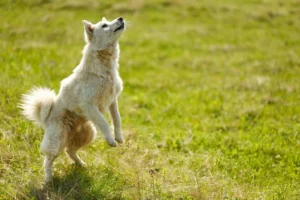Disclosure: We may earn a commission from helpful, relevant links in our content. No cost to you. See our privacy policy.
Waking up to another chewed-up shoe? Staring in disbelief at the overturned trash can, with your dog looking guiltily on?
Ah, the joys of dog ownership. Sometimes, you may wonder how on earth you’re supposed to communicate with your dog about their missteps.
The trick is to communicate in a language your dog understands – the language of behavior and reinforcement. This not only helps you maintain your cool but also ensures a better response from your dog.
And you know what? It doesn’t take a dog whisperer to master this. A few tweaks in your reactions can make a world of difference.

Did Your Dog Make a Mess? How to React Properly
Oh dear, so Fido knocked over the vase again. Before you let out that sigh of exasperation, hold on. Your reaction is key here.
If you react calmly and assertively instead of with frustration, you’re less likely to instigate fear or aggression in your dog.
Remember, your dog didn’t knock over the vase out of spite – they just don’t understand the human world as we do. Try guiding them gently away from the scene of the ‘crime’ and calmly restoring order.
You might be surprised at how quickly they pick up on your calm demeanor.
Avoid the Shouting and Why Punishing Doesn’t Work
It can be easy to shout in frustration when your dog misbehaves. But let’s consider this from your dog’s perspective.
Yelling only creates fear for the dog, and scared dogs are more likely to misbehave. This is a vicious cycle that you should try to avoid.
And punishing your dog? It doesn’t teach them what they did was wrong. Instead, it associates you with fear and negativity.
The key here is to focus on what your dog should be doing instead.
If they’re chewing on your furniture, provide them with appropriate chew toys. If they’re begging for food, teach them to sit or lay down at a distance while you’re eating. Remember, it’s about teaching, not punishing.
By focusing on desired behaviors, you can start building a better bond and behavior pattern with your dog.
Positive Reinforcement: Teaching Your Dog the Right Way
Let’s change the narrative from “don’t do that” to “do this instead”.
It’s time to tap into the power of positive reinforcement. The idea here is straightforward – rewarding good behavior makes it more likely to happen again.
But here’s the twist: don’t just stick to the regular “sit” and “stay” commands. Expand your horizons. Encourage behaviors like ‘quiet time’ when you’re busy working or ‘focus on me’ when you’re in a crowded place.
These aren’t standard commands, but they’re essential for peaceful cohabitation.
Your rewards can also be diverse. Treats, verbal praise, a belly rub, or their favorite toy – it all works! But here’s a unique tip: try a ‘jackpot reward’ for exceptionally good behavior. This is a big, unexpected reward – like a handful of their favorite treats or an extra-long playtime.
The surprise element increases the effectiveness of the reinforcement.
Remember, positive reinforcement isn’t a one-size-fits-all approach – it’s an art that involves understanding what motivates your dog the most.

Let’s Talk Triggers: How to Anticipate Misbehavior
Anticipating misbehavior is like catching a ball before it hits the ground. It’s not about being reactive; it’s about being proactive. And that comes from understanding your dog’s triggers.
For instance, if your dog always chews on the rug when left alone, they might be suffering from separation anxiety. In this case, providing them with interactive toys or gradually acclimatizing them to short periods of separation might help.
But here’s where my years of dog training experience come in handy – often, it’s not just about identifying the triggers, it’s also about identifying the early signs before the trigger takes full effect.
For example, before your dog lunges at another dog, there might be subtle signs, like stiffening of the body, intense staring, or raised hair on their back.
If you can spot these signs and distract your dog before they react, you’ll be two steps ahead in managing their behavior.
For a quick reference to better understand what may cause your dog to misbehave, here are a few common triggers in dogs:
- Separation. Some dogs feel anxious when left alone, which might lead to destructive behavior.
- Loud Noises. Sudden, loud sounds like fireworks or thunder can be a major trigger for many dogs.
- New People or Animals. Dogs can be territorial, and new faces (both human and animal) might cause them to act out.
- Changes in Environment. Changes in living arrangements or routines can throw a dog off balance, causing them to behave erratically.
Recognizing these common triggers allows you to anticipate and mitigate possible negative reactions.
Keeping a behavior diary for your dog can be a great way to identify patterns and manage triggers effectively. Write down the incidents of misbehavior, the circumstances, and your dog’s reactions. Over time, you’ll start to notice patterns which can be invaluable in anticipating and preventing unwanted behavior.
Remember, understanding triggers isn’t about blaming your dog. It’s about helping them navigate through the world in a way that’s stress-free for both of you.
Connecting With Your Dog for Better Behavior
At the core of a well-behaved dog lies a deep, meaningful bond between the canine and its owner. Building this connection isn’t about grand gestures, it’s about the little things.
Try to understand your dog’s body language – their eyes, tail, ears, all provide invaluable insight into their state of mind.
Learning your dog’s body language is crucial in assessing their emotional state and potential triggers. Here’s a simple table to help you decipher some common dog body language signals:
| Body Language | Possible Meaning |
| Tail wagging | Excitement, but also potential fear or insecurity depending on the tail’s position |
| Ears perked up | Alert, curious |
| Showing belly | Submissive, trustful, or in a playful mood |
| Growling | Warning, fear, or possession over something |
| Whining | Desire for attention, pain, or anxiety |
| Yawning | Stress, or just tired |
Please note that these are general interpretations and might vary based on the individual dog’s personality and situation.
A great way to connect with your dog is to spend quality time with your dog beyond training and walks. Simply lying down with them, playing fetch or engaging in activities they love can build trust and respect.
A unique tip often overlooked is the power of talking to your dog. Yes, a simple chat. While they might not understand all your words, dogs are exceptional at reading tone and emotion. Sharing your day, laughing, or even singing can foster a strong emotional connection.
Finally, always respect your dog’s personal space and teach others to do the same. Every good relationship is based on respect and understanding, and it’s no different with your furry friend.
Remember this guy? A famous video of a dog looking guilty and how he handled it, funny stuff and I “have to” share this:
FAQ
Can dogs understand human emotions when they do something wrong?
Dogs can pick up on subtle changes in human emotions through body language, tone, and behavior, which can guide their understanding of whether their action was right or wrong. But when they make that guilty face, it’s more about your own reaction, than anything else.
Are there certain signals to avoid giving my dog after it misbehaves?
After misbehavior, avoid rewarding your dog with attention, even negative, as it can reinforce the undesired behavior. Instead, redirect their focus to positive actions.
How soon should I react after my dog does something wrong?
React to your dog’s misbehavior immediately, ideally within seconds. This helps your dog connect the consequence with the action.
What if my dog keeps repeating the same mistake?
If your dog continues to repeat a mistake, revisit and modify your training approach. Consistency, positive reinforcement, and understanding the root cause can help rectify recurring misbehavior.
Alex, a passionate animal lover, has experience in training and understanding animal behavior. As a proud pet parent to two dogs and three cats, he founded AnimalReport.net to share insights from animal experts and expand his knowledge of the animal kingdom.




